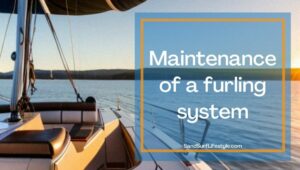Changing from a mainsail furler to a standard mainsail setup can be a significant modification to your sailboat. A mainsail furler, also known as a roller furler, allows the mainsail to be rolled up and stowed away quickly and easily. While convenient, some sailors still prefer a traditional mainsail setup for improved performance and control.
The cost of changing the furlers

The cost of changing from a mainsail furler to a standard can vary significantly depending on the type of boat and existing rigging setup. Generally speaking, switching to a standard rig will require new mainsail hardware, such as a masthead block, halyard, mainsheet, and other components.
In addition, existing running rigging may need to be replaced or modified to accommodate the new configuration. As such, the total cost of changing to a standard rig can range anywhere from a few hundred dollars to several thousand dollars. It’s important to note that these costs should be weighed against the advantages of a standard rig before making any decisions.
Which is easier to use?
One of the biggest factors to consider when changing from a mainsail furler to a standard setup is the ease of use. The furler system provides an automated and streamlined way of managing the sail, allowing you to simply unfurl or furl the sail with minimal effort.
A standard setup, on the other hand, requires more effort and manual labor. You have to hoist the sail, tie it off, and take time to ensure that it is properly set. If you are new to sailing or don’t have a lot of experience, this can be intimidating. Additionally, if your boat is going through big waves or strong winds, it can be difficult to control the sail in a standard setup, as opposed to the furler system which does the work for you.
Ultimately, it comes down to personal preference and what kind of sailing you plan on doing. If you prefer simplicity and automation, then a furler system may be the right choice. If you prefer a more traditional approach and greater control, then a standard setup may be the better option.
How to Reef a Roller Furling Mainsail
Maintenance of a furling system
The key difference between a mainsail furler and a standard sail’s upkeep is how much effort is required to keep them both in top condition. With a mainsail furler, you are likely to spend more time and effort doing regular maintenance and inspection. This is because you have to make sure the furling system is working correctly and that the sail is properly tensioned and adjusted. Additionally, you will need to check for any wear and tear on the lines, swivels, cleats, and other components that make up the furling system.

In contrast, you can generally get away with less frequent checking of a standard sail. However, if your sail does experience any damage or wear, you will need to take it in for repairs as soon as possible to ensure your safety and performance. Additionally, you should inspect the sail regularly for any signs of fraying or other wear and tear.
Overall, the maintenance requirements of both types of sails will depend on how often they are used and the sailing conditions they experience. Regardless, both types require some level of regular maintenance to ensure they remain in good condition and perform optimally.
The weight factor of furlers
The weight of the furling system is an important factor to consider when making the switch from a mainsail furler to a standard. The extra hardware and parts associated with a furling system add weight to the sail, which can affect performance, especially in lighter air. On the other hand, a standard mainsail will be slightly lighter, allowing for more maneuverability and better performance.
For sailors looking to maximize their performance in light air, going with a standard mainsail could be the way to go. In terms of total weight, the difference between a mainsail furler and a traditional system is often minimal, but it can be enough to give a slight performance advantage in certain conditions. For heavier boats or cruisers that are not looking for maximum performance in light air, the extra weight of the furler is usually negligible and not a significant factor.
Removing a Furling Mainsail: 4 Steps
The visuals of a furling system
When it comes to aesthetics, the choice between a mainsail furler and a standard mainsail will come down to personal preference. A mainsail furler offers a sleek, modern look that many sailors appreciate. It is also very easy to furl and unfurl the sail without any manual effort, which can look great when sailing.
On the other hand, a standard mainsail gives the boat a classic look and feel, and there is something satisfying about setting and striking a sail by hand. Ultimately, whether you choose a furler or standard mainsail will depend on what look you prefer for your boat.
Conclusion

Switching from a mainsail furler to a standard is a big decision and there are many things to consider like its cost, ease of use, required maintenance, weight, and aesthetics. It’s important to understand the pros and cons of making this change so that you can continue sailing smoothly with your family and friends.
Four Steps to Install a Furling Mainsail
This blog post is provided for informational purposes only. The information contained is not intended to constitute legal advice or to substitute for obtaining legal advice from a qualified attorney.

